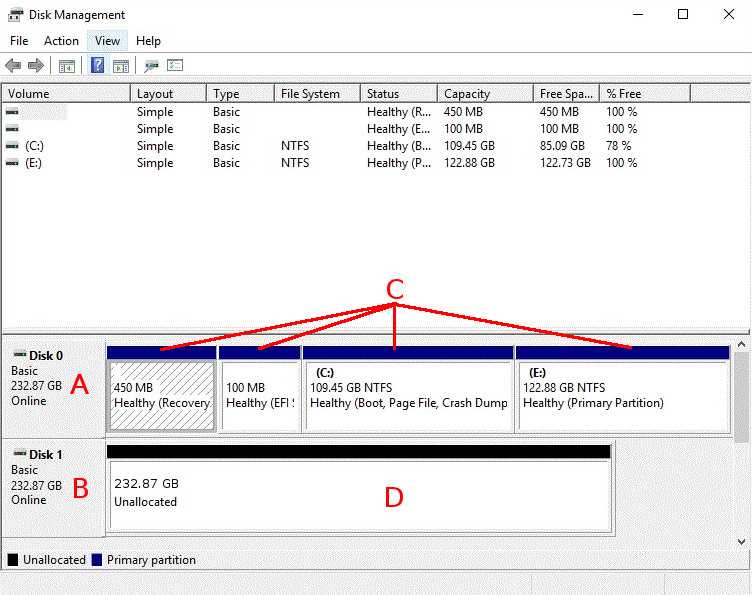Windows Server Software RAID
Introduction
The following guide describes how to manually setup a drive mirroring (RAID1) in a Windows operating system.Preparation
1. First, please click on the Windows symbol in the bottom left corner, or press the Windows or Super key.
2. Type diskmgmt.msc and press the Enter key to open the Disk Management Utility.
Please find a quick overview of the utility below:
A: Main disk, which contains the operating system
B: Second disk, intended to be used for the RAID1 mirroring
C: Volumes (means partitions under Windows) on the main disk
D: Unallocated space on the second disk
3. If your second disk already has Volumes on it, please right-click on them and choose Delete Volume on all of them.
4. Right-click on the disk which currently contains the operating system and click on Convert to dynamic disk.
5. In the dialog that then appears, the main drive should already be selected. Please also select the other drive which you would like to use for the RAID1. Click on Ok and confirm.
6. Now you have to determine if your system has been installed in Legacy Mode, or in UEFI Mode. To do this, please click on the Windows symbol in the bottom left corner, or press the Windows or Super key.
7. Type msinfo32.exe and press the Enter key to open the System Information window.
8. In the right side of the window, you should see the BIOS MODE entry, which has the correct mode (Legacy or UEFI) as its value. If you cannot find this entry, the system is installed in the Legacy mode. Now, continue below to either “Legacy” or “UEFI”.
Legacy
If your system is running in Legacy mode, you should do the following steps on all the Volumes of the main disk. Work on the Volumes from left to right:
1. Right-click on a Volume and choose Add mirroring from the context menu.
2. In the menu that appears, choose the second drive you would like for the RAID1. Then confirm by clicking on Add mirroring.
Please check that you have correctly added all the Volumes to the mirroring. Also check that the synchronization is running, which is indicated by the reddish colored Volumes and their status information.
UEFI
Every UEFI system has a UEFI System Volume. This partition cannot be mirrored automatically by Windows; you need to manually copy and configure it on the second drive. Like with Legacy, add the mirroring for the Volumes one by one, from left to right.* For all Volumes, that do not have the EFI label, follow those steps:
1. Right-click on a Volume and choose Add mirroring from the context menu.
2. In the menu that appears, choose the second drive you would like for the RAID1. Then confirm this by clicking on Add mirroring.
* For the UEFI System Volume, please use the following steps:
1. Create an UEFI System Volume with the same size on the second drive and format it with FAT32. To do this, just right-click on the unallocated space of the second drive, select New Simple Volume and follow the dialog.
2. Copy the UEFI System Volume data from the first drive to the second. To do that, we recommend that you boot the server to the Rescue System and connect to it via SSH:
* Locate the correct partitions:
parted -l
This command will list the partitions of all drives. There, please search for two UEFI partitions on both drives which you might identify by their sizes and filesystem (FAT32) and combine the disk identifiers (/dev/sdX) with the correct numbers of the partitions.
Example:
parted -l
Model: WD Enterprise P20691
Disk /dev/sda: 2000GB
Sector size (logical/physical): 512B/512B
Partition Table: msdos
Disk Flags:
Number Start End Size Type File system Flags
1 1049kB 101MB 100MB primary fat32
2 102MB 2000GB 1999GB primary ntfs
Model: WD Enterprise P20691
Disk /dev/sda: 2000GB
Sector size (logical/physical): 512B/512B
Partition Table: msdos
Disk Flags:
Number Start End Size Type File system Flags
1 1049kB 101MB 100MB primary fat32
2 102MB 2000GB 1999GB primary ntfs
In this case, the partitions are /dev/sda1 and /dev/sdb1.
* Create mount point folders:
mkdir /mnt/main
mkdir /mnt/second
* Mount the correct UEFI System partitions. (Replace the partitions with the ones you have found):
mount -t vfat /dev/sda1 /mnt/main -o rw,umask=0000
mount -t vfat /dev/sdb1 /mnt/second -o rw,umask=0000
* Next, copy all the files from the current UEFI System partition to the new one:
cp -ar /mnt/main/ /mnt/second/
* Once you’re finished, boot the server back to the installed system:
reboot
Important note: The UEFI System partition can’t be mirrored. The process as described above is therefore always required if you replace a drive or if you have make changes to the bootloader configuration.
Please ensure that you have added all other Volumes to the mirroring. And check that the synchronization is running, which is indicated by the reddish colored Volumes and their status information.
If you face any issues with certain Volumes, or the second Plex (which is a part of a mirrored Microsoft Volume) is not bootable, please see the official documentation.


